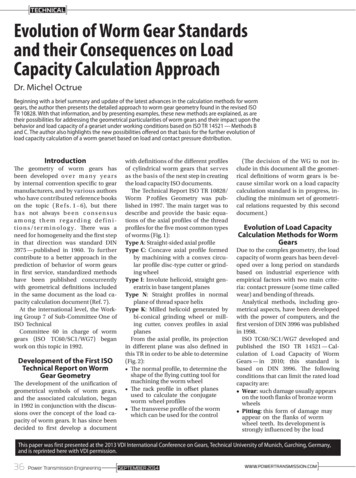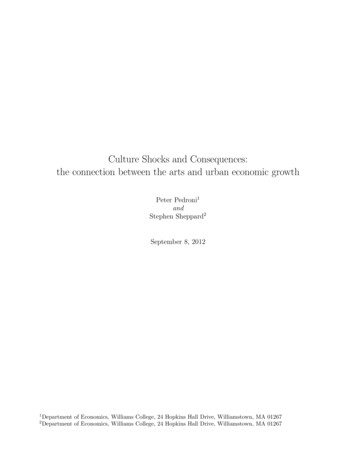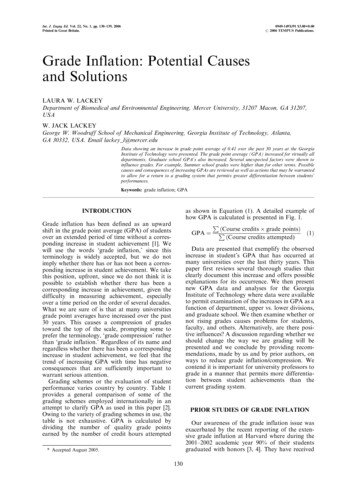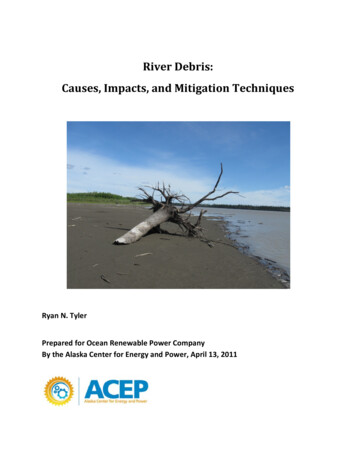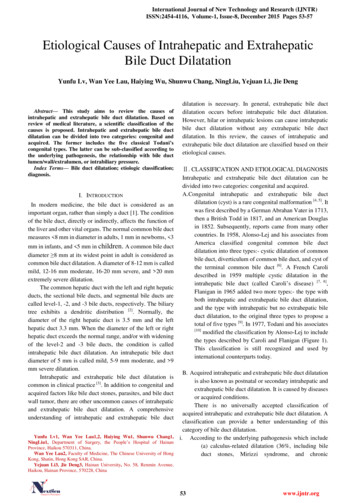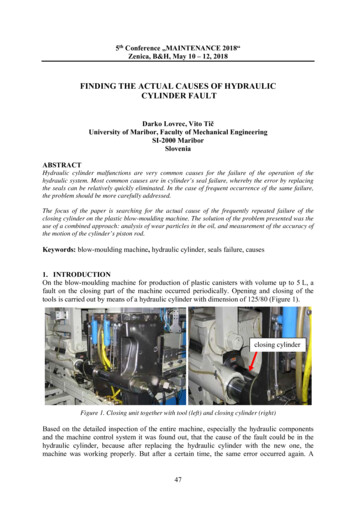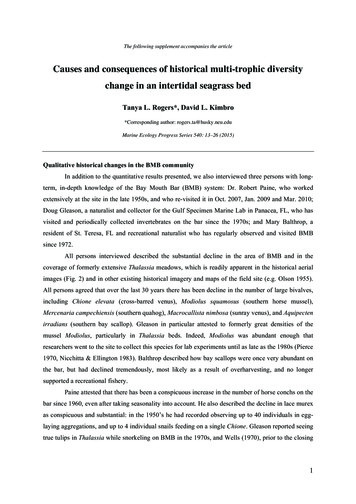
Transcription
The following supplement accompanies the articleCauses and consequences of historical multi-trophic diversitychange in an intertidal seagrass bedTanya L. Rogers*, David L. Kimbro*Corresponding author: rogers.ta@husky.neu.eduMarine Ecology Progress Series 540: 13–26 (2015)Qualitative historical changes in the BMB communityIn addition to the quantitative results presented, we also interviewed three persons with longterm, in-depth knowledge of the Bay Mouth Bar (BMB) system: Dr. Robert Paine, who workedextensively at the site in the late 1950s, and who re-visited it in Oct. 2007, Jan. 2009 and Mar. 2010;Doug Gleason, a naturalist and collector for the Gulf Specimen Marine Lab in Panacea, FL, who hasvisited and periodically collected invertebrates on the bar since the 1970s; and Mary Balthrop, aresident of St. Teresa, FL and recreational naturalist who has regularly observed and visited BMBsince 1972.All persons interviewed described the substantial decline in the area of BMB and in thecoverage of formerly extensive Thalassia meadows, which is readily apparent in the historical aerialimages (Fig. 2) and in other existing historical imagery and maps of the field site (e.g. Olson 1955).All persons agreed that over the last 30 years there has been decline in the number of large bivalves,including Chione elevata (cross-barred venus), Modiolus squamosus (southern horse mussel),Mercenaria campechiensis (southern quahog), Macrocallista nimbosa (sunray venus), and Aquipectenirradians (southern bay scallop). Gleason in particular attested to formerly great densities of themussel Modiolus, particularly in Thalassia beds. Indeed, Modiolus was abundant enough thatresearchers went to the site to collect this species for lab experiments until as late as the 1980s (Pierce1970, Nicchitta & Ellington 1983). Balthrop described how bay scallops were once very abundant onthe bar, but had declined tremendously, most likely as a result of overharvesting, and no longersupported a recreational fishery.Paine attested that there has been a conspicuous increase in the number of horse conchs on thebar since 1960, even after taking seasonality into account. He also described the decline in lace murexas conspicuous and substantial: in the 1950’s he had recorded observing up to 40 individuals in egglaying aggregations, and up to 4 individual snails feeding on a single Chione. Gleason reported seeingtrue tulips in Thalassia while snorkeling on BMB in the 1970s, and Wells (1970), prior to the closing1
of the channel, reported that F. tulipa densities on BMB did not appear different from those reportedby Paine (1963).The role of human collection in altering community structure of BMB and in driving downaverage snail size is unclear. Wells (1970) notes an absence of larger individuals compared to Paine(1963) that he cites may be due to human collection. Horse conchs, true tulips, and lightning whelksare harvested by humans on the Gulf Coast of Florida; however, current population estimates in otherseagrass beds in the region suggest that they are not overexploited (Stephenson et al. 2013).Collection of large snails on BMB has been occasionally reported, but never in great intensity.Besides scallops, Balthrop had not observed other bivalve or gastropod species being heavilyharvested from the bar, and posits that their decline is probably not due to overcollecting. Gleasonalso did not believe his occasional collection activities had any noticeable effect on molluscpopulations. In our monthly surveys, conducted during the periods when the bar is most accessible,we only rarely observed other people on the bar, and their collections, if any, appeared limited toempty snail shells and the few remaining Macrocallista nimbosa. The abundant and conspicuoushorse conchs currently on BMB, which are a main target of collectors, also suggests that collection atthe site is likely minimal.Other carnivorous gastropodsPaine (1963) discusses 2 additional carnivorous gastropod species in addition to the 6 specieswe focus on in this study. These two species were the moon snail (Neverita duplicata, formerlyPolinices duplicatus) and ear shell (Sinum perspectivum). In our interview, Paine reported that in hisrecent visits, these two snails species appeared to have increased on BMB since 1959. These arebivalve-drilling species, which we were not able to effectively survey due to their burrowing behaviorand largely subterranean existence. They are likely abundant on the bar, and may also havecontributed to declines in bivalves. As competitors to lace murex, these species may also be playing apart in BMB community dynamics, which we were not able to examine in this study. As a preliminaryway to assess the abundance of moon snails, we collected all whole (intact), dead Chione valves froma subset of the quadrats taken during our summer infaunal survey. We also fed live Chione todifferent snail species in the lab in order to identify the characteristic marks that each leaves on theshell of this clam species. Of the 312 valves collected from BMB, 23% were drilled at the base in theway characteristic of moon snails, 8% were shaved in the way characteristic of lightning whelks, and3% were drilled close the lip with a more steeply-sided bore hole, which is more characteristic of lacemurex and oyster drills (Urosalpinx). In contrast, of 92 Chione values collected from 8 quadrats in thearea where lace murex were collected for the field experiment, 16% were drilled in the manner ofmoon snails, 3% were shaved in the manner of lightning whelks, and 11% were drilled in the mannerof lace murex and oyster drills.2
Gastropod burrowing behaviorUnlike moon snails and ear shells, the 6 large gastropods on which we focused our surveysmust move and feed above ground. However, with the exception of horse conchs and lace murex,these snails are known to burrow when inactive. Since current and historical surveys only countedsnails that were on the surface of BMB, estimates of snail density are undoubtedly underestimates oftrue density, and we must assume consistency in burrowing behavior between 1959-1960 and 20122013. Since it was not possible to survey buried snails, we attempted to quantify the relativeburrowing behavior of each species by recording when living tethered snails in the experiment werefound buried vs. on the surface (Fig. S5). The percentage of snails found buried varied substantiallybetween species, with lightning whelks showing the highest rate of burial, and lace murex showingthe lowest (after horse conchs, none of which were found buried). Observations we made in thelaboratory suggested that burial may act as a defense against predation by horse conchs, which werenot able to consume lightning whelks, pear whelks, and banded tulips that had been permitted to burythemselves in sediment (which they did readily) prior to introducing a horse conch. Lace murex didnot bury themselves in the laboratory, and were readily captured and consumed by horse conchs. Thislack of burrowing behavior by lace murex may partly explain the high susceptibility of this species tohorse conch predation in the field.Preferential habitat use by gastropodsDuring the monthly field surveys, we recorded the habitat type in which we found each snailas a way to test for preferential habitat use. We also recorded the habitat type present at 306 predetermined GPS points evenly-spaced across the BMB study area in July 2012 and January 2013. Wecompared whether the number of each gastropod species we observed in each habitat type during thefield surveys differed from the background distribution of habitat types using Chi-Square tests.Habitat types were Halodule, Thalassia, Mixed Halodule/Thalassia, Sand, and Other. The “Other”category was rare, and excluded in Chi-square analysis.We found that proportion of snails in each habitat differed from the background distributionof habitat types on the sandbar (Chi-Square test, p 0.001; Fig. S6). Horse conchs were found inThalassia more often than expected if snails were randomly distributed, banded tulips were moreoften found in Halodule, and lightning whelks and pear whelks were more often found in sand.Habitat distribution in the winter and summer background surveys did not differ (Chi-square test,p 0.33), although seagrass was much sparser in the winter due to seasonal dieback.Naturally occurring bivalves in experimental plotsIn addition to the tethered clams, we also assessed differences in naturally occurring bivalvesin the experimental plots. At the end of the experiment, we excavated two 0.25 x 0.5 m quadrat areasfrom within each experimental plot. The quadrats were dug to 5 cm depth, and sieved in field through3
a 5 mm mesh sieve. Bivalves, small gastropods, and small crabs were collected, and were sorted andidentified in the lab. Other animals (e.g. echinoderms, ascidians, tubes of large polychaetes) wereenumerated in the field.Compared to control plots, MLCA-only treatments had no effect on the naturally occurringinfaunal community (PERMANOVA; MLCA, F2,33 0.649, p 0.892, R2 0.057). The infaunalcommunity was affected only by habitat type (PERMANOVA; habitat, F1,33 5.26, p 0.001, R2 0.23), and there was no significant interaction between MLCA and habitat type. Across allexperimental treatments (excluding controls to allow for a balanced dataset) infaunal communitycomposition was also only affected by habitat (PERMANOVA, F1,33 10.55, p 0.001, R2 0.195).Consumer treatment and predator treatment had no effect on community composition, and there wereno significant interactions (all p-values 0.38).Literature CitedNicchitta C V, Ellington WR (1983) Energy metabolism during air exposure and recovery in the highintertidal bivalve mollusc Demissa granosissima and the subtidal bivalve mollusc modiolussquamosus. Biol Bull 165:708–722Olson F (1955) The hydrography of Alligator Harbor, Franklin County Florida. OceanographicInstitute Florida State University, TallahasseePaine RT (1963) Trophic Relationships of 8 Sympatric Predatory Gastropods. Ecology 44:63–73Pierce SK (1970) The water balance of Modiolus (Mollusca: Bivalvia: Mytilidae): osmoticconcentrations in changing salinities. Comp Biochem Physiol 36:521–533Stephenson SP, Sheridan NE, Geiger SP, Arnold WS (2013) Abundance and distribution of largemarine gastropods in nearshore seagrass beds along the gulf coast of Florida. J Shellfish Res32:305–313Wells FE (1970) An ecological study of 2 sympatric species of Fasciolaria (Mollusca: Gastropoda) inAlligator Harbor. The Veliger 13:95–1084
Table S1. Diet of gastropods in 1959-1960 (Paine 1963) and in 2012-2013. “Small snails” includesmoon snails, turban snails, drills, Nassarius vibex, and similar species. “Large snails” includeslightning whelks, pear whelks, banded tulips, true tulips, and lace murex.Lightning whelk1959-19602012-2013Pear whelkBanded chaete3126Barnacle141513424CarrionHorse 17Scallop71511Oyster22Jingle shell2311Ark shell4Pen shellGastropodsSmall snail113Large snail131524Total obs172551076891152106618Table S2. Most common bivalve species in Halodule in 1959-1960 (Paine unpublished data) and in2013. The 1959-1960 species are unranked. The 2013 species are ranked starting with numericallymost abundant. Bolded species not shared between lists.1959-19602013Stewartia (Lucina) floridanaAnadara transversaChione elevata (cancellata)Chione elevata (cancellata)Carditamera (Cardita) floridanaGeukensia granosissimaMactroma fragilisMactroma fragilisMercenaria campechiensisCumingia tellinoidesMacrocallista nimbosaAngulus texanusEnsis megistus (minor)Ensis megistus (minor)Atrina spp.Laevicardium mortoniTagelus divisusTagelus divisus5
Fig. S1. Time series of gastropod densities on BMB from Paine (1963) and the current study. Shadedmonths indicate the “winter” season (December-March).6
Fig. S2. Abundance of infaunal species and functional groups in different habitat types on BMB inJanuary (winter) and July (summer) 2013. Data are means /- 1 SE.7
Fig. S3. Density of bivalves in Halodule in 1959 (R. Paine unpublished data) and in 2013. Bivalvedensity excluded the mussel Geukensia granosissima, which was very patchily distributed. Data aremeans /- 1 SE. Numbers on bars are sample sizes (number of quadrats).Fig. S4. Survival curves for the four mid-level consumer species used in the field experiment,averaged across all treatments.8
Fig. S5. Percentage of living tethered snails that were found buried during the field experiment.Includes all observations during all checks.Fig. S6. Habitat types on BMB based on evenly spaced points, and habitat types in which snails werefound. Mixed H/T mixed Halodule and Thalassia. “Other” includes Syringodium filiforme, andmixtures of Syringodium filiforme with Halodule and/or Thalassia.9
murex and oyster drills (Urosalpinx). In contrast, of 92 Chione values collected from 8 quadrats in the area where lace murex were collected for the field experiment, 16% were drilled in the manner of moon snails, 3% were shaved in the manner of lightning whelks, and 11% were drilled in the
